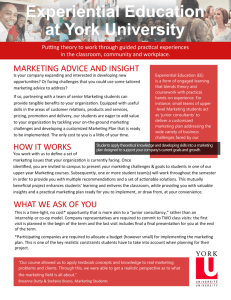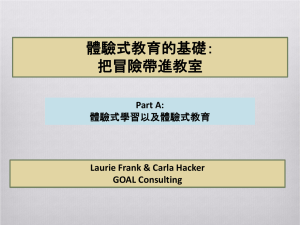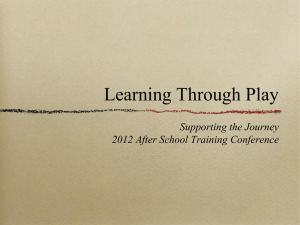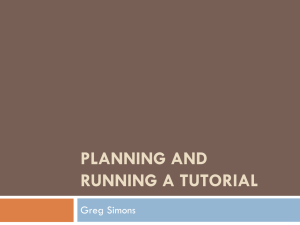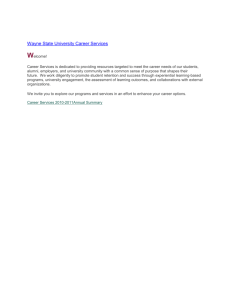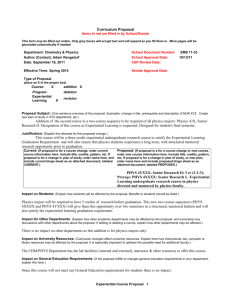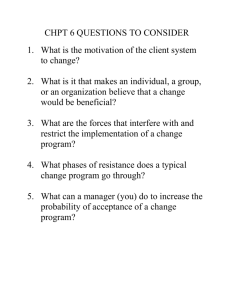LSS 09-01 COM 446 Advertising Management exl-curr
advertisement
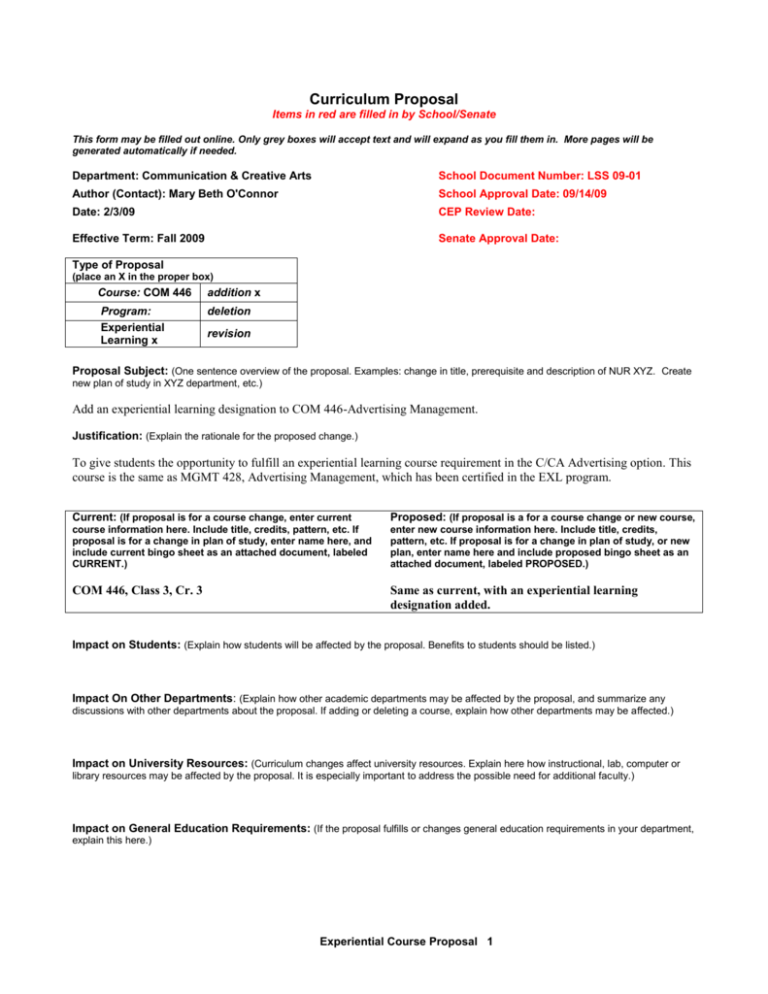
Curriculum Proposal Items in red are filled in by School/Senate This form may be filled out online. Only grey boxes will accept text and will expand as you fill them in. More pages will be generated automatically if needed. Department: Communication & Creative Arts School Document Number: LSS 09-01 Author (Contact): Mary Beth O'Connor School Approval Date: 09/14/09 Date: 2/3/09 CEP Review Date: Effective Term: Fall 2009 Senate Approval Date: Type of Proposal (place an X in the proper box) Course: COM 446 addition x Program: Experiential Learning x deletion revision Proposal Subject: (One sentence overview of the proposal. Examples: change in title, prerequisite and description of NUR XYZ. Create new plan of study in XYZ department, etc.) Add an experiential learning designation to COM 446-Advertising Management. Justification: (Explain the rationale for the proposed change.) To give students the opportunity to fulfill an experiential learning course requirement in the C/CA Advertising option. This course is the same as MGMT 428, Advertising Management, which has been certified in the EXL program. Current: (If proposal is for a course change, enter current Proposed: (If proposal is a for a course change or new course, course information here. Include title, credits, pattern, etc. If proposal is for a change in plan of study, enter name here, and include current bingo sheet as an attached document, labeled CURRENT.) enter new course information here. Include title, credits, pattern, etc. If proposal is for a change in plan of study, or new plan, enter name here and include proposed bingo sheet as an attached document, labeled PROPOSED.) COM 446, Class 3, Cr. 3 Same as current, with an experiential learning designation added. Impact on Students: (Explain how students will be affected by the proposal. Benefits to students should be listed.) Impact On Other Departments: (Explain how other academic departments may be affected by the proposal, and summarize any discussions with other departments about the proposal. If adding or deleting a course, explain how other departments may be affected.) Impact on University Resources: (Curriculum changes affect university resources. Explain here how instructional, lab, computer or library resources may be affected by the proposal. It is especially important to address the possible need for additional faculty.) Impact on General Education Requirements: (If the proposal fulfills or changes general education requirements in your department, explain this here.) Experiential Course Proposal 1 CEP Curriculum Document Form For Experiential Learning Courses Standards of Practice of the National Society for Experiential Education Course COM 446, Advertising Management Department Communication Standards of Practice. Please provide the information requested below for each of the eight standards of practice. 1. Intention – Intention represents the purposefulness that enables experience to become knowledge and is deeper than the goals, objectives, and activities that define the experience. Example: Content of course overview, purpose of the course, etc. 2. Preparedness & Planning –Identified intentions are set as goals and specific objectives and activities are defined for the course. Example: Forms and syllabus standards operationalized/scheduled 3. Authenticity – The experience must have a real world context and/or be useful and meaningful in reference to an applied setting or situation. Example: Standard site proposal agreement with goals, tasks, application. Learning goals, tasks, application would be as determined by the course. 4. Reflection – The learner must test assumptions and hypotheses about the outcome of decisions and actions taken, then weigh the outcomes against past learning and future implications. Example: Dialogic group events, journals, surveys, etc. 5. Orientation & Training – Students, community partner(s), and faculty are prepared with important background information about each other and about the context and environment in which the experience will operate. Additionally, ongoing structural development should be addressed in an effort to increase the appreciation of the context and skill requirements of her/his work. Evidence (Type responses in grey boxes.) For CEP Use Only (Circle One) Please describe the INTENTION of the course. Students will take this course towards the end of their degree program. It is an interdisciplinary course also taken by the Management/Marketing Department’s students. The project will require students to utilize the knowledge from their coursework to solve a real business problem, working with a local business. Yes No Please demonstrate how students will be academically PREPARED to participate in experiential learning. Course work in the degree program will provide students with skills in basic communication and business functions. Their upper level major courses required in the program will give students specific industry knowledge. The specific objective is to analyze, recommend, and implement an advertising campaign for a business. Yes No Please demonstrate how this course has specific real world context and/or is an out-of-class experience which is AUTHENTIC. Students will receive the guidance of faculty and local company representatives, while developing an advertising campaign, implementing the campaign, and tracking the results of the plan. Yes No Please demonstrate in specific ways how assignments provide students the opportunities to meaningfully REFLECT on their experience. Students will analyze the advertising problem and write a report of their analysis, they will submit written recommendations to address problems identified in the analysis, work with appropriate company representatives to implement recommendations, and track the results. At the end of the course, students will present their plan to company representatives and supervising faculty member, outlining the project and results. Yes No Please demonstrate how students will be prepared for the experience through an ORIENTATION which is appropriate to the context. To prepare for the course assignment, students will have prior projects to review. A history of the local company they will be working with will be provided, and a meeting will be held with the faculty member, students, and business representatives to discuss status of business web advertising. Example: Checklist form with skills, Experiential Course Proposal 2 Yes No tasks, preparation acquired CEP Curriculum Document Form For Experiential Learning Courses Standards of Practice of the National Society for Experiential Education Course COM 446, Advertising Management Department Communication Experiential Course Proposal 3 Standards of Practice. Please provide the information requested below for each of the eight standards of practice. 6. Monitoring – A student-teachercommunity partner feedback loop related to learning intentions and quality objectives. The structure of the experience permits change in response to the implications of the feedback. Example: Checklist form with dates, review, consults, meetings, weekly student /instructor meetings, mid semester contact with site supervisor, etc. 7. Assessment & Evaluation – Assessment is a means to refine the specific learning goals and quality objectives identified during the planning stages of the experience. Evaluation provides comprehensive data about the experiential process as a whole and whether it has met the intentions. Example: Grades, reports, community partner or site evaluations, faculty evaluations, self-evaluations, performance reviews, student evaluations, etc. 8. Acknowledgment – All parties and individuals involved in the experience should be included in the recognition of progress and accomplishment. Example: Faculty summary reports, students ratings, site surveys, presentation of project to site, poster sessions, recognition of student on website, informal or formal gathering, Ex L Expo, transcript notation of experience, etc. Type of Experience __ Cooperative Education __ Design Project __ Internship __ Cultural Immersion __ Practicum __ Undergraduate Research __ Service Learning Evidence (Type responses in grey boxes.) Please demonstrate how students will receive feedback and opportunities to improve their performance through effective MONITORING . Students will meet either in person, or by phone conference, to discuss project progress and recommend the next step in the process. The supervising faculty member will monitor the various reports, as they are produced, and provide appropriate feedback. Please demonstrate how students will be ASSESSED and EVALUATED. Throughout the semester, the project reports will be evaluated by the faculty member and company representatives for viability and appropriateness for that particular business. Please show how students will be ACKNOWLEDGED for the learning they have experienced in this course. At the end of the semester, all students undertaking design projects will have an opportunity to present their projects to the other students, faculty, and business representatives. For CEP Use Only (Circle One) Yes No Yes No Yes No Please indicate the type of Experiential Learning this course involves. Yes If more than one type applies, please indicate which is the PRIMARY (P) category and which is the SECONDARY (S). No P-Design Project Experiential Course Proposal 4
